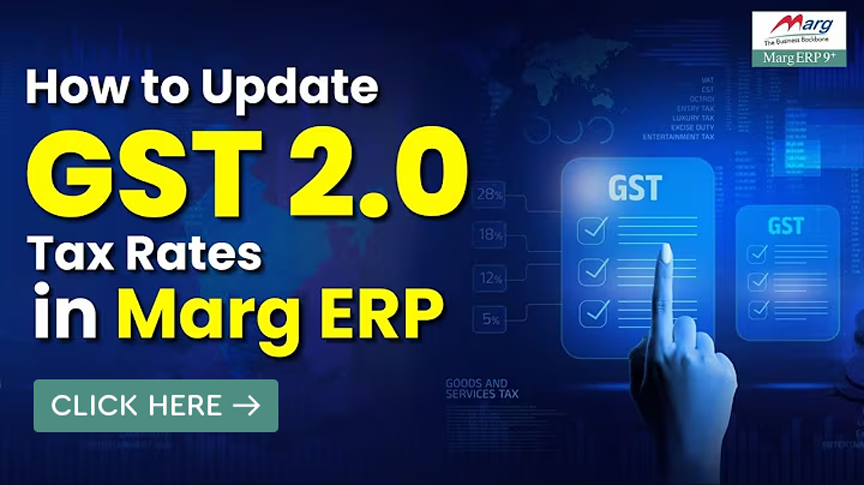Search by Category
- Marg Nano
- Swiggy & Zomato
- ABHA - Ayushman Bharat
- Marg Cloud
-
Masters
- Ledger Master
- Account Groups
- Inventory Master
- Rate and Discount Master
- Refresh Balances
- Cost Centre Master
- Opening Balances
- Master Statistics
- General Reminder
- Shortage Report
- Supplier Vs Company
- Temporary Limit
- Shop QRID and eBusiness
- Cloud Backup Setup
- Password and Powers
- Marg Licensing
- Marg Setup
- Target
- Budget
- Credit Limit Management
- Change ERP Edition
- Ease Of Gst Adoption
-
Transactions
- ERP To ERP Order
- Sale
- Purchase
- Sale Return
- Purchase Return
- Brk / Exp Receive
- Scrap Receive
- Brk / Exp Issue
- Scrap Issue
- GST Inward
- GST Outward
- Replacement Issue
- Replacement Receive
- Stock Issue
- Stock Receive
- Price Diff. Sale
- Price Diff. Purchase
- BOM
- Conversion
- Quotation
- Sale Order
- Purchase Order
- Dispatch Management
- ERP Bridger
- Transaction Import
- Download From Server
- Approvals
- Pendings
- Accounts
- Online Banking
-
Books
- Cash and Bank Book
- All Ledgers
- Entry Books
- Debtors Ledgers
- Creditors Ledger
- Purchase Register
- Sale Register
- Duties & Taxes
- Analytical Summaries
- Outstandings
- Collection Reports
- Depreciation
- T-Format Printing
- Multi Printing
- Bank Reconcilation
- Cheque Management
- Claims & Incentives
- Target Analysis
- Cost Centres
- Interest and Collection
- Final Reports
-
Stocks
- Current Stock
- Stock Analysis
- Filtered Stock
- Batch Stock
- Dump Stock
- Hold/Ban Stock
- Stock Valuation
- Minimum Level Stock
- Maximum Level Stock
- Expiry Stock
- Near Expiry Stock
- Stock Life Statement
- Batch Purchase Type
- Departments Reports
- Merge Report
- Stock Ageing Analysis
- Fast and Slow Moving Items
- Crate Reports
- Size Stock
-
Daily Reports
- Daily Working
- Fast SMS/E-Mail Reports
- Stock and Sale Analysis
- Order Calling
- Business on Google Map
- Sale Report
- Purchase Report
- Inventory Reports
- ABC Analysis
- All Accounting Reports
- Purchase Planning
- Dispatch Management Reports
- SQL Query Executor
- Transaction Analysis
- Claim Statement
- Upbhogkta Report
- Mandi Report
- Audit Trail
- Re-Order Management
- Reports
-
Reports Utilities
- Delete Special Deals
- Multi Deletion
- Multi Editing
- Merge Inventory Master
- Merge Accounts Master
- Edit Stock Balance
- Edit Outstanding
- Re-Posting
- Copy
- Batch Updation
- Structure/Junk Verificarion
- Data Import/Export
- Create History
- Voucher Numbering
- Group of Accounts
- Carry Balances
- Misc. Utilities
- Advance Utilities
- Shortcut Keys
- Exit
- Generals
- Backup
- Self Format
- GST Return
- Jewellery
- eBusiness
- Control Room
- Advance Features
- Registration
- Add On Features
- Queries
- Printing
- Networking
- Operators
- Garment
- Hot Keys
-
GST
- E-Invoicing
- Internal Audit
- Search GSTIN/PARTY
- Export Invoice Print
- Tax Clubbing
- Misc. GST Reports
- GST Self-Designed Reports
- GST Return Video
- GSTR Settings
- Auditors Details
- Update GST Patch
- Misc. GST Returns
- GST Register & Return
- GST RCM Statement
- GST Advance Statement
- GST Payment Statement
- Tax Registers and Summaries
- TDS/TCS Reports
- Form Iss./Receivable
- Mandi
- My QR Code
- E-Way Bill
- Marg pay
- Saloon Setup
- Restaurant
- Pharmanxt free Drugs
- Manufacturing
- Password and Power
- Digital Entry
Home > Margerp > Gstr 4 > FAQs: On GSTR 4
FAQs: On GSTR 4
1. What is GSTR-4?
GSTR-4 is a GST Return that has to be filed by a Composition Dealer. Unlike a normal taxpayer who needs to furnish 3 monthly returns,
A dealer opting for the composition scheme is required to furnish only 1 return which is GSTR-4.
2. Who should file GSTR-4?
A taxpayer opting for the Composition Scheme is required to file GSTR-4
>Turnover under Rs 1.5 Cr to file quarterly GSTR-1 ( EXAMPLE :BINOD COMPANYSALES TURNOVER :1.5 CR. LIKE DATA AS ON:1-04-2016 TO 31-03-2017)
>Turnover above Rs 1.5 Cr to file monthly GSTR-1.
3.GSTR-4 due dates
Period (Quarterly) Due dates
July- Sept 31st Dec 2017
Oct- Dec 15th Feb 2018
Jan- Mar 30th April 2018
4.GSTR-4 Filing
The GST Portal has recently started the offline process for GSTR-4 filing. Online facility is also expected to be available soon.
5.GSTR-4 Offline Filing Process
GSTR-4 Offline Filing tool can be downloaded from the GST Portal. Login is not required.
There are 7 steps of filing:
1.Downloading & Installation the GSTR4 Offline Tool
2.Entering details in the GSTR4 Offline Tool
3.Validating Details
4.Creating the JSON File
5.Upload JSON file on GST Portal
6.Open Downloaded Return File for GSTR4
7.Submission and Filing of GSTR4
6. What if GSTR-4 is not filed?
A penalty of Rs. 200 per day is levied if the GSTR-4 is not filed.
The maximum penalty that can be charged is Rs. 5,000.
Also, if the GSTR-4 is not filed for a given quarter, then the taxpayer cannot file the next quarter’s return.
7. How to revise GSTR-4?
GSTR-4 cannot be revised after filing on the GSTN Portal. Any mistake in the return can be revised in the next month’s return only. It means that.
if a mistake is made in the GSTR-4 filed for the July-September quarter, the rectification for the same can be made only when filing the next quarter’s GSTR-4.
8.Parts of the GSTR-4 Offline Utility Meaning & how to fill this forms?
>There are 10 tabs in the excel. We will go through them in brief mentioned following:
1.Read Me
>It provides the introduction to the GSTR4 Offline Excel Tool in brief. It also has the instructions and explanations of each of the items in the subsequent sheets.
2.Home Tab
This is the main page where you will generate the JSON file after furnishing all details.
You are required to enter the following fields-
GSTIN
Financial Year from the drop-down list
Tax Period from the drop-down list
All other information will automatically flow from the other tabs.
3.4B(B2B)
>Inward Supplies received from a registered supplier (attracting reverse charge).
4.C(B2BUR)
> Inward Supplies received from an unregistered supplier
5.4D(IMPS)
> Import of Services
6.5B(CDNR)
> Debit Notes/Credit Notes (for registered)
7.5B(CDNUR)
> Debit Notes/Credit Notes (for unregistered)
8.6(TXOS)
>Tax on outward supplies made
This is the tab for the sales data. Data has to be given on a consolidated basis instead of detailed invoice basis. The composition dealer must enter his net turnover against his relevant tax rate. Net turnover is calculated from total turnover after adjusting advances and goods return.
For example, if he is a manufacturer, he will enter his sales against the 2% rate. Taxes will be calculated automatically.
9.8A(AT)-
>Advance amount paid for reverse charge supplies in the tax period
This tab will contain details of advance amount paid for reverse charge supplies in the tax period.
Place of supply, rate, type of supply (inter or intra state) must be selected from the drop-down list along with gross advance value. Taxes will be calculated automatically.
10.8B(ATADJ)-
>Advance amount on which tax was paid in earlier period but invoice has been received in the current period
This tab is regarding advances on which tax was paid in earlier period but invoice has been received in the current period, i.e., for normal advances paid on purchases which do not attract reverse charge.
Generate the return in CSV/Excel Returns format
Once the changes are made, generate the return containing only those invoices in which changes have been made in CSV/Excel Returns Format.
- Convert the CSV/Excel in JSON Format through GST Offline Utility Tool
Now upload the file with the help of GST Offline Utility Tool and convert the CSV/Excel R


 -
Marg ERP 9+
-
Marg ERP 9+











